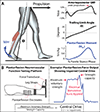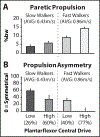Central Drive to the Paretic Ankle Plantarflexors Affects the Relationship Between Propulsion and Walking Speed After Stroke
- PMID: 31834220
- PMCID: PMC8049399
- DOI: 10.1097/NPT.0000000000000299
Central Drive to the Paretic Ankle Plantarflexors Affects the Relationship Between Propulsion and Walking Speed After Stroke
Abstract
Background and purpose: The ankle plantarflexor muscles are the primary generators of propulsion during walking. Impaired paretic plantarflexion is a key contributor to interlimb propulsion asymmetry after stroke. Poststroke muscle weakness may be the result of a reduced force-generating capacity, reduced central drive, or a combination of these impairments. This study sought to elucidate the relationship between the neuromuscular function of the paretic plantarflexor muscles and propulsion deficits across individuals with different walking speeds.
Methods: For 40 individuals poststroke, we used instrumented gait analysis and dynamometry coupled with supramaximal electrostimulation to study the interplay between limb kinematics, the neuromuscular function of the paretic plantarflexors (ie, strength capacity and central drive), propulsion, and walking speed.
Results: The strength capacity of the paretic plantarflexors was not independently related to paretic propulsion. Reduced central drive to the paretic plantarflexors independently contributed to paretic propulsion deficits. An interaction between walking speed and plantarflexor central drive was observed. Individuals with slower speeds and lower paretic plantarflexor central drive presented with the largest propulsion impairments. Some study participants with low paretic plantarflexor central drive presented with similarly fast speeds as those with near-normal central drive by leveraging a compensatory reliance on nonparetic propulsion. The final model accounted for 86% of the variance in paretic propulsion (R = 0.86, F = 33.10, P < 0.001).
Discussion and conclusions: Individuals poststroke have latent paretic plantarflexion strength that they are not able to voluntarily access. The magnitude of central drive deficit is a strong indicator of propulsion impairment in both slow and fast walkers.Video Abstract available for more insights from the authors (see the Video, Supplemental Digital Content 1, available at: http://links.lww.com/JNPT/A298).
Figures





